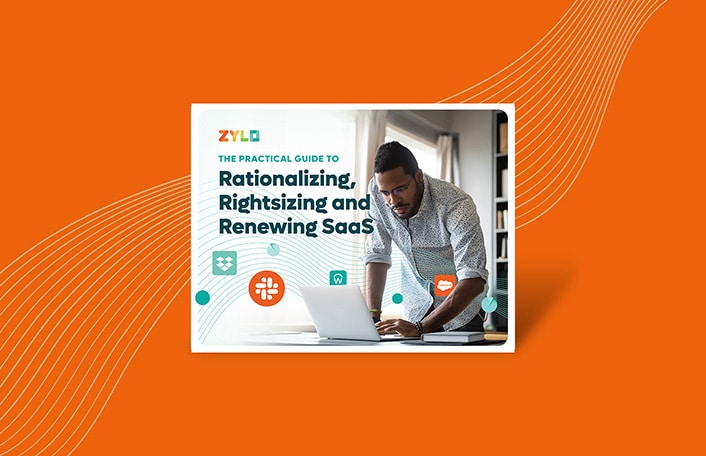
The Practical Guide to Rationalizing, Rightsizing and Renewing SaaS
Optimizing your investments in SaaS with the 3R’s of SaaS Management...
Back
Back
Search for Keywords...
Blog

Table of Contents
For many businesses today, the future is full of uncertainty. Looming tariffs. Rising costs. Impending recession. Unfortunately, no one has a crystal ball to divine what the future holds. But there is one thing that can help future proof your business: software cost reduction.
We’ve seen it time and again. Companies reduce their workforce to cut costs and get their budget in check. But if we look at the numbers, software is often an organization’s second largest operating expense. You don’t need to choose between your people and your budget. The waste is already in your software stack.
Today, lines of business and employees are responsible for a majority of software purchases—84% of applications and 74% of spending. When IT lacks visibility into the full software environment, it’s easy to see how SaaS sprawl forms.

Worse, companies who don’t proactively manage their apps could see upwards of 33% portfolio growth annually. As a result, waste runs rampant, including redundant applications, shelfware, unused licenses, and more.
When this financial waste is removed, it enables organizations to be more agile, reinvest in the business, and ensure a viable future. However, this requires finesse. Software spending needs more than a simple reduction; it needs optimizing.
From reinvestment opportunities to business scalability. Software cost reduction offers a myriad of future-proofing benefits for any business that uses SaaS.
One benefit of software cost reduction is that it allows your business to maximize its technology investments. This means getting the most value out of your SaaS applications. Are you using all of the purchased licenses? And is everyone with a premium license using the premium features?
There may well be entire applications going unused or underused in your SaaS stack that are cutting into your budget. By practicing proper software cost reduction practices, you can identify where spending is being wasted, so you can put every dollar to use.
By reducing software costs, you free up funds for other initiatives. This is a lesson that Brad Pollard, the former CIO of Tenable, learned early during the Covid-19 pandemic.
Pollard was walking around the office and noticed a lot of unused phones on the desks. Instead, everyone was using Zoom and Slack to communicate. That was the moment he realized that this was an opportunity.
“I went into Zylo to look at the adoption of my unified communications as a service,” said Pollard. “I looked at the bill we were paying to see, ‘where can I save money?’”
Pollard discovered that the customer service team was still using the service. However, throughout the rest of the business, it was going unutilized. Based on that data, Pollard and his team decided to move the voice IP to Zoom Phone for a fraction of the cost.
“We ended up saving a ton of money. We stayed flat on budget, not losing any functionality, and then had money to do innovation and new projects.”
— Brad Pollard, former CIO at Tenable
If the pandemic taught us anything, it’s that the whole world can turn on its head overnight. Even now, we face an unpredictable economic environment. Many leaders are unsure whether we’ll go into a recession or how tariffs will impact the operations and financial stability of their businesses.
Reducing software costs allow businesses to create a financial buffer to provide stability. Whether that’s a volatile economic environment or the regular ups and downs of business, a financial buffer reduces risk and gives you peace of mind.
Budget cuts impact line items across the business, but often the hardest hit area is headcount. By saving money on software, you can avoid budget cuts in other areas of the business. That could also mean saving the job of one or more of your employees.
Scaling an organization doesn’t happen overnight. It’s the results of individual, strategic decisions made over time. Establishing a SaaS Management program that drives software cost reduction is one such decision.
It’s not just a one-and-done project. You must operationalize SaaS Management so that you’re regularly finding and taking action on opportunities to eliminate waste. By following this approach, you can save money and make the most of your tech investments while improving operational efficiency for the business.
To put this another way, smart investment into business practices like SaaS Management do more than just support company growth. They allow teams to do more with less.
“With growth companies, you can’t grow your IT staff linearly with the rest of the company. You need to do more with less.”
— Brad Pollard, former CIO at Tenable
Before you can begin reducing software costs, you must have visibility into all the apps in your inventory. That means understanding what apps you have, how much you’re spending, and the utilization or consumption of each app.
Why is this important? If you operate with just part of the picture, your software cost reduction efforts won’t be as effective. To understand the importance of visibility to cost management, let’s look at a few examples.
Without visibility—and ongoing discovery—your SaaS portfolio will continue to grow. And with it, increased spending. In fact, our data shows that the average company adds 7 new apps each month. Over the course of a year, that means your portfolio could grow by 33% if you’re not proactively managing it.
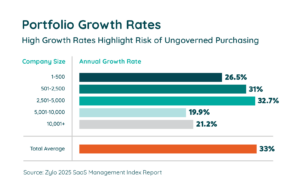
While any savvy business leader wants to stay ahead of this financial risk, the problem is front and center today. The average company has 275 applications and spends $49M on SaaS annually. Yet, organizations often largely underestimate those figures by 2X and 3X, respectively. This gap between perception and reality means you don’t know what you’re spending. And you can’t reduce costs you don’t know exist.
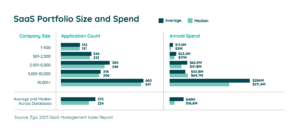
Having a full picture of your SaaS spending makes it easier to see where there’s waste—especially expensed software, or shadow IT. In contrast, a lack of visibility into shadow IT means unexpected costs, inaccurate forecasting, and a drain on budgets.
According to Zylo’s 2025 SaaS Management Index, expensed software accounts for 45% of your stack and 1% of spend. While this isn’t a high-dollar risk, it can add up quickly. If you consider that the average large enterprise spends $284M annually, expensed apps would total $2.8M.
In terms of software cost reduction, remediating shadow IT can be a quick win to save money and improve governance of SaaS purchasing.
Beyond the application level, license usage is a significant driver of financial waste. Our data shows that the average organization uses just 47% of their SaaS licenses—or $21M wasted annually.
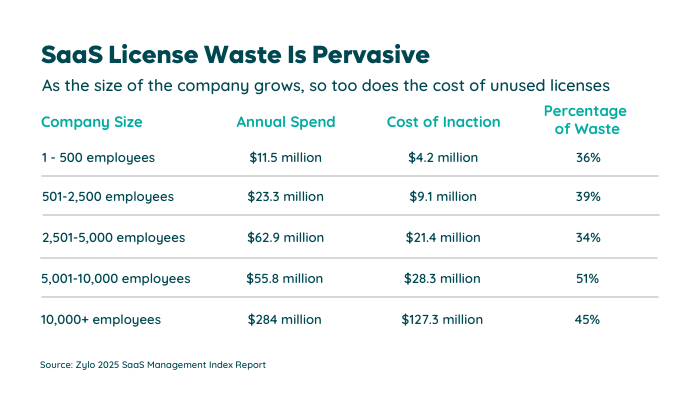
That’s where visibility into licensing matters. By centralizing utilization data in a system of record, you can identify apps with unused licenses and optimize them. Software cost reduction then comes at the time of renewal, where you can rightsize and renegotiate with your vendor.
Battling cost inefficiencies without cutting effectiveness requires a methodical approach and the right tactics. Let’s examine a few highly-effective ways to reduce software costs.
As mentioned before, license waste is one of the biggest culprits of increasing software spending, with the average organization wasting $21M annually. The solution? SaaS license optimization.
SaaS license optimization includes:
The key is to pay only for what you need, while ensuring a healthy buffer for growth. Optimally, that’s 90% of licenses provisioned. But what if utilization is less than that? Depending on the use case for the application (e.g. monthly vs daily use), the expectation of “good” may differ.
For example, let’s say your company uses Zoom as its video conferencing tool. Because users regularly utilize the tool, it’s reasonable to consider a license not used in the last 30 days as inactive. You have 2,000 users, but based on that threshold, only 1,000 users are active. Survey users that fit that criteria to determine which licenses you can claw back or downgrade to a free license. Then, at renewal, you can rightsize those licenses in your contract and drive software cost reduction.
ModMed Drives Operational Excellence & Million-Dollar Savings with Zylo SaaS License Management
Discover how ModMed used Zylo’s powerful license tracking and optimization to save millions of dollars, drive operational excellence, and improve the employee experience.
Remediating shadow IT is an effective and quick method for driving software cost reduction. If your expense spend is greater than 1% of your total SaaS spending, this may be a good opportunity to pursue.
Effective shadow IT remediation starts with visibility into SaaS costs and spend sources. For long-term success it requires proper governance to prevent further risk to your business.
These best practices will help you reduce the shadow IT footprint in your organization.
“SaaS purchased by individuals and business units wasn’t going through our standard due diligence. Our goal is to stop the purchase of SaaS applications being expensed, and we’re driving that behavior through Zylo.”
— Cal Brown, Technology Procurement Manager at REA Group
Every company’s SaaS portfolio is riddled with unproductive, outdated, redundant, and unnecessary tools. As discussed before, the average company has 275 apps. But it’s also bloated with tools that aren’t driving value for the business, creating a prime opportunity for software cost reduction.
Application rationalization is an essential tactic to remove these tools and eliminate unnecessary spending. In our analysis of the top redundant app functions—online training classes, project management, and team collaboration tools—we found an average of up to $2.8M in potential cost savings. All by consolidating overlapping tools.
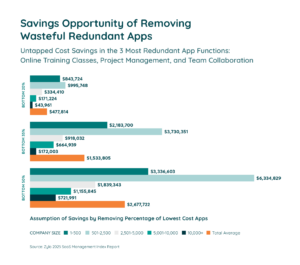
Follow these steps to rationalize your software stack:
Adobe Drives Innovation and Massive Savings with Zylo
In the past 4 years, Adobe has rapidly scaled from $9B to $18B. This growth has made an already complex environment even more complex. Learn how they leveraged Zylo to get complete visibility into their SaaS portfolio, unlock millions in cost savings and avoidance and improve the employee experience.
Software cost reduction can only become a reality at the point of renewal, when you can make changes to the contract. For instance, you may want to rightsize licenses or cancel an app that’s no longer needed.
The challenge is that procurement teams have a ton of renewals on their plate—one per business day on average, or 247 annually. Without proactive renewal management, it’s easy to miss these cost-saving opportunities.
To stay ahead of each renewal, follow these steps:
Proactive renewal management ensures you’re prepared with the right data and negotiation tactics to drive your desired cost-savings outcomes.
Guide to Managing SaaS Costs
Learn MoreSoftware cost reduction is a critical outcome for many businesses today—securing its longevity and future success. But as decentralized purchasing continues to drive portfolio growth and increased costs, this will become increasingly difficult to combat.
Organizations with a SaaS Management program built on a foundation of complete, ongoing visibility will be one step ahead.
The time is now to get started. With Zylo’s SaaS renewal and spend management solution, you can reduce software costs and add cash to your bottom line. For a peek under the hood, view the interactive tour, or request a personalized demo.

Optimizing your investments in SaaS with the 3R’s of SaaS Management...
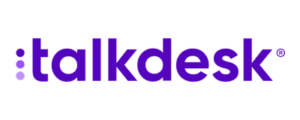
Discover how Talkdesk’s IT and procurement teams use Zylo to improve SaaS negotiations and cross-functional collaboration, while saving time and money.

Table of Contents ToggleHow Software Cost Reduction Helps Future Proof Your...

Table of Contents ToggleHow Software Cost Reduction Helps Future Proof Your...
| Cookie | Duration | Description |
|---|---|---|
| cookielawinfo-checkbox-analytics | 11 months | This cookie is set by GDPR Cookie Consent plugin. The cookie is used to store the user consent for the cookies in the category "Analytics". |
| cookielawinfo-checkbox-functional | 11 months | The cookie is set by GDPR cookie consent to record the user consent for the cookies in the category "Functional". |
| cookielawinfo-checkbox-necessary | 11 months | This cookie is set by GDPR Cookie Consent plugin. The cookies is used to store the user consent for the cookies in the category "Necessary". |
| cookielawinfo-checkbox-others | 11 months | This cookie is set by GDPR Cookie Consent plugin. The cookie is used to store the user consent for the cookies in the category "Other. |
| cookielawinfo-checkbox-performance | 11 months | This cookie is set by GDPR Cookie Consent plugin. The cookie is used to store the user consent for the cookies in the category "Performance". |
| viewed_cookie_policy | 11 months | The cookie is set by the GDPR Cookie Consent plugin and is used to store whether or not user has consented to the use of cookies. It does not store any personal data. |
